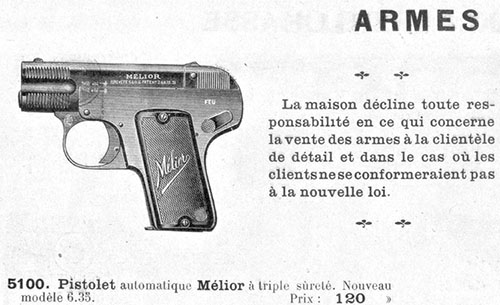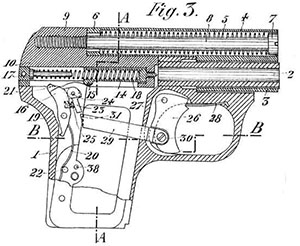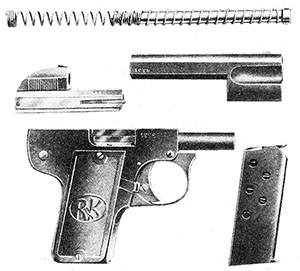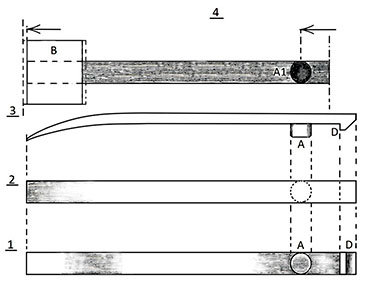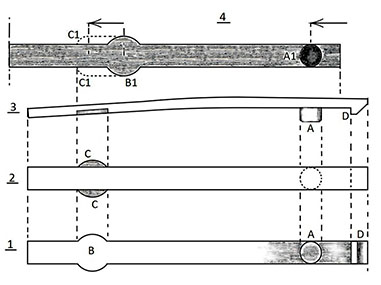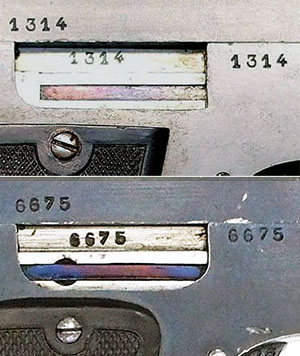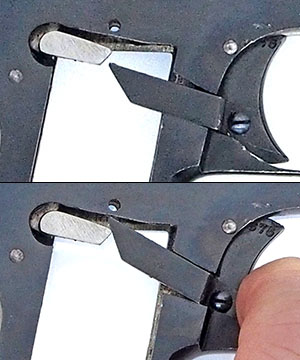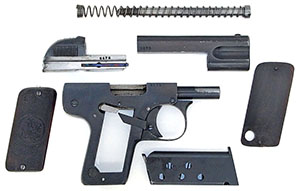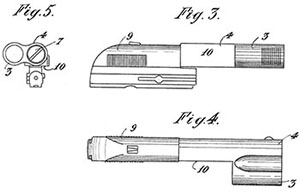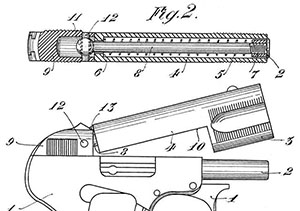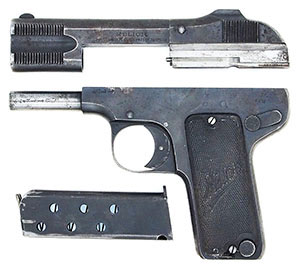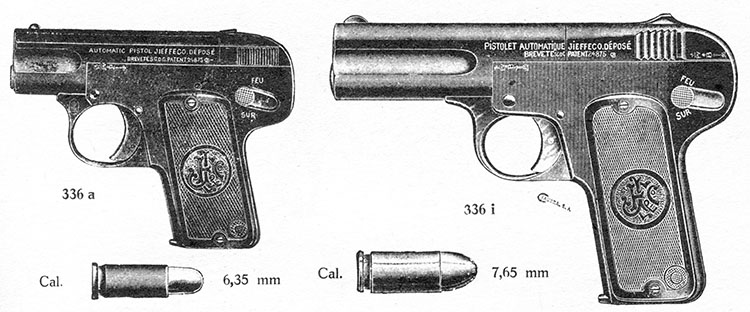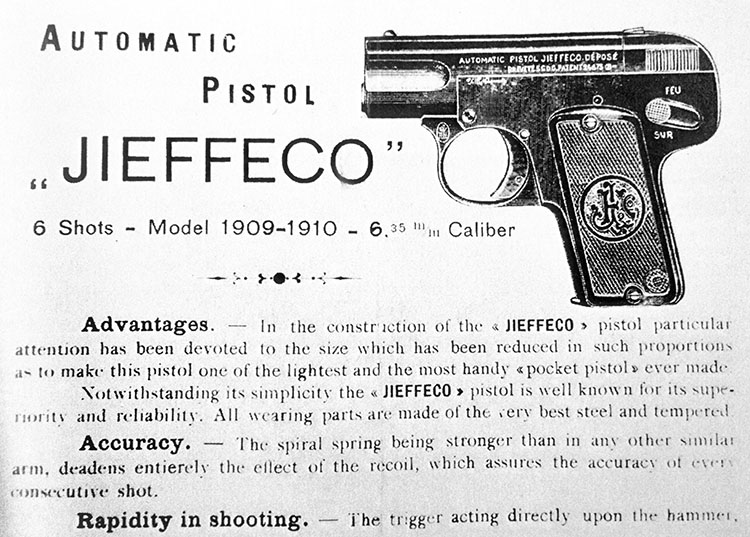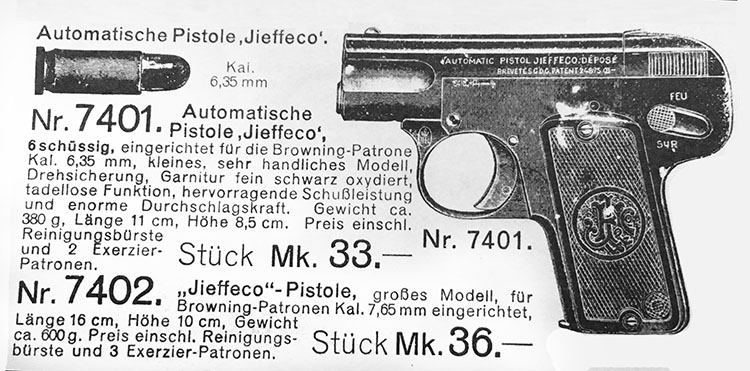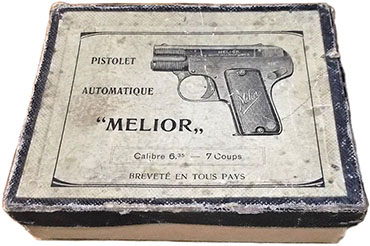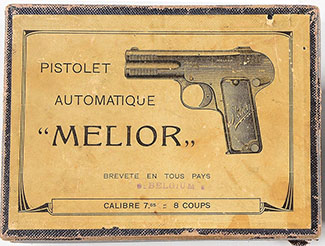|
Nomenclature
 |
Model 1907
|
|
 |
Model 1911
|
|
 |
Model 1914
|
 |
|
|
|
The early version of the Robar & de Kerckhove pistol (lacking serrations at the front of the barrel)
is usually referred to as the Model 1907, after the date of the Belgian patent, or sometimes as the Model 1908, after the date of the British patent which appears on some guns. Early manuals for
both the Melior and Jieffeco refer to the gun as the Model 1909; and an early English-language advertisement refers to the gun as the Model 1909-1910.
The second version of the Robar & de Kerckhove pistol (with serrations at the front) is most often referred to as the Model 1911. This gun has sometimes also been referred to as the Model 1912,
after the foreign patent dates. We have been unable to locate a manual for the Model 1911 in order to determine how the company may have referred to it, but one advertisement we have lists it as
the “Nouveau modèle” or “New Model.” Unfortunately, this is also how the Model 1914 pistol has sometimes been referred to by various collectors to distinguish it from the Model 1907/1911 “old
model.” The Model 1914 is also referred to in an early manual as the “improved model.” Due to
possible confusion caused by all these names, we have found it preferable to standardize on model numbers based on patent dates.
The 1907 Rosier Patent
Henri Rosier’s second patent for an automatic pistol, Belgian patent № 204029, was filed on 21 November 1907, and granted on 30 November 1907. Nearly
identical patents were filed in Switzerland on 25 July 1908, in the U.S. on 18 November 1908, and in France and Great Britain on 19 November 1908. The British patent was granted in 1909, but the U.S. and Swiss
patents were not granted until 1910. Interestingly, it is the British patent number which appears on the production pistols: № 24875-08.
The patent shows a gun that is externally quite similar to the Model 1899 or 1900 FN Browning, with the recoil spring above a fixed barrel and an unlocked breech.
However, upon closer examination it becomes clear that Rosier’s design carefully avoids infringing upon any of Browning’s patents. There is no reciprocating slide but
instead a reciprocating bolt or breech block, and the internal design is quite different. An external transfer bar runs beneath the grip on the right side of the gun. There is no true disconnector to prevent movement of the sear
when the breech block is out of battery, but instead a “Mécanisme de déclenchement”, or “release mechanism” that requires the trigger to be released and pulled again to fire another cartridge.
The design consists of the frame with fixed barrel, the breech block, an upper receiver housing which serves as a sleeve for the barrel and a housing for the recoil spring, and a recoil spring
guide rod which screws into the breech block to hold the gun together.
Model 1907 Technical Information
The gun is substantially as described in the Belgian patent № 204029 of 1907, and also in the British patent № 24875 of 1908. The forward nose of the sear is
pushed up by the end of the transfer bar, which then passes beyond it and cannot re-engage until the trigger is released and pulled again. The manual safety locks the sear, positively preventing release of the striker. There is
no magazine safety. The ejector has a pin on the back side that is press-fit into a hole in the left side of the frame just above the grip plate.
The bolt or breech block reciprocates in the frame and has an upper extension into which the recoil spring guide rod is screwed. This extension has 15 fine triangular-cut
vertical serrations in a raised panel at its rear to assist in retracting the breech block to chamber a cartridge. The striker and its spring are held captive in the breech block by a pinned plug at the rear.
The earliest guns (up to at least serial number 5042 and possibly later*) show an extractor with a pinched flat area at the end that is press fit into a cut in the breech
block. The ejection port has a single rounded corner at the lower left. This early configuration is shown in photographs in the early manuals (see above). In later guns (second variation - from at least serial number 5161
and possibly earlier*) the spring steel extractor is built on a similar pattern to that of the 1899/1900 FN Browning, with a round protrusion near the end that locks into a hole in the breech block. This is the configuration shown in the patent drawings. Second variation ejection ports are rounded on both lower corners.
The 7.65mm pistol is simply a scaled-up version of the 6.35mm, and looks remarkably like the 1899/1900 Browning pistol. Like the smaller gun it has 15 vertical triangular-cut serrations in a raised panel on the bolt. The magazine holds seven cartridges and has six holes for viewing cartridges in each
side. Grip plates are made of checkered horn. Jieffeco grip plates feature the JF&Co. monogram in a circle in the middle of the grip. Melior grip plates feature the word “Melior” written in script at
an angle in the middle of the grip.
|
Field Stripping the Model 1907
-
Remove the empty magazine and verify that the chamber is empty.
- Unscrew the recoil spring guide rod above the barrel (carefully, as it is under spring tension), and remove the guide rod and recoil spring.
- Pull the recoil spring housing from the front of the gun.
- Pull the bolt or breech block from the rear of the gun.
Note: When reinstalling the bolt, you must pull the trigger to lower the sear.
|
|
|
The 1910 Rosier Patent
Henri Rosier’s third patent for an automatic pistol, Belgian patent № 230218, was filed on 31 October 1910 as an addendum to the original patent № 204029, and
was granted on 21 November 1910. The patent was for a design that allowed disassembly of the gun without tools. To disassemble for cleaning, one grasped the upper housing and pulled it forward far enough that the rear
portion cleared the frame and the lower portion cleared the barrel, then twisted it 90 degrees and eased the housing and the attached breech block off the frame to the
rear. We believe this patent was implemented on a very limited basis, with only slightly more than 100 guns possibly made--perhaps as many as 150--but with serrations at the front of the recoil
spring housing as shown in the next patent. The patent states that: “The front part of the receiver housing and the [barrel] sleeve advantageously have grooves or serrations, which make it possible
to grasp the piece more easily.” These are shown in the patent illustration as fine serrations on the bottom of the barrel sleeve. This patent was not filed outside Belgium, unlike Rosier’s third patent.
The 1911 Rosier Patent
Henri Rosier’s fourth patent for an automatic pistol, Belgian patent № 233222, was filed on 17 February 1911 as an addendum to the original patent № 204029,
and was granted on 28 February 1911. Similar patents were filed in Great Britain and Switzerland on 12 January 1912, and in the U.S. on 18 January 1912. All were granted before the end of 1912. Rosier and/or
Robar probably realized that the design of his previous patent, while an improvement over the original design, was likely to cause damage to the finish of the gun with repeated disassembly; so the third patent features a
design wherein the recoil spring guide rod has a ball on the rear end with a transverse screw which secures it in the bolt or breech block. This allows the guide rod and front housing to be
rotated upward so that the front housing need not come in contact with the frame during removal. The sides of the front housing are serrated for ease of gripping. With these innovations, the gun can
be disassembled for cleaning in seconds, and without damage to the components.
Field Stripping the Model 1911
- Remove the empty magazine and verify that the chamber is empty.
- Grasp the recoil spring housing by the serrations at the front and pull it forward until it clears the end of the barrel.
- Lift the recoil spring housing above the barrel and ease the attached bolt off the rear of the frame.
Note: When reinstalling the bolt, you must pull the trigger to lower the sear.
|
|
|
Advertisements
Boxes
* Write to edbuffaloe@unblinkingeye.com.
|
|
|
References
- Brandt, Jakob H. “Magazine der Selbstladepistolen Jieffeco und Melior”. Deutsche Waffen Journal, June 1995.
- Daubresse, Alain. Les armuriers Liègeois a travers leurs réalisations. Alain Daubresse: 2014.
- Daubresse, Alain. littlegun.be
- Gadisseur, Guy and Druart, Michel. Le Qui est Qui: de l’Armurierie liégeoise, 1800-1950, Tome 1, Editions du Pecari: 2005.
- Hogg, Ian and Walter, John. Pistols of the World, 4th Edition. Krause Publications, Iola, WI: 2004.
- Hogg, Ian V. and Weeks, John. Pistols of the World. Arms & Armour Press, London: 1978.
- Matthews, J. Howard, Firearms Identification. Charles C. Thomas, Springfield, Illinois: 1962.
- Olson, John, Editor. Famous Automatic Pistols and Revolvers, Volume 2. Jolex.
- Schroeder, Joseph J. Jr., Editor. Arms of the World 1911: The Fabulous ALFA Catalogue of Arms and the Outdoors. Follett Publishing Company, Chicago: 1972.
Early Melior, Jieffeco, and Phoenix Serial Numbers
Rebirth of the Phoenix
Thanks to Stefan Klein for research assistance and photographs.
Thanks to Michel Druart for providing us with Henri Rosier’s
patents.
Thanks also to Guido Grenny, Marco Benecci, Ashley Jason Smith, and Roland Adam from the luger.gunboards forum, Janne Salopuro at www.fusil.fi, and the online store at www.puskarstvinovotny.cz.
|
|
|


